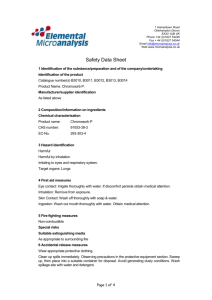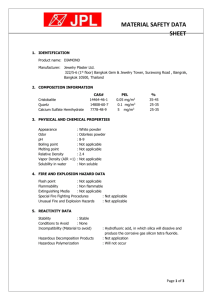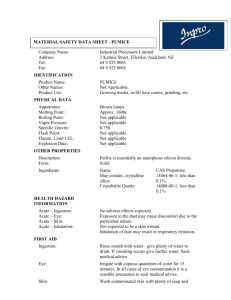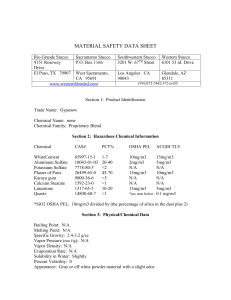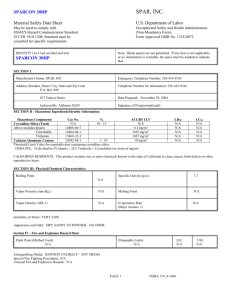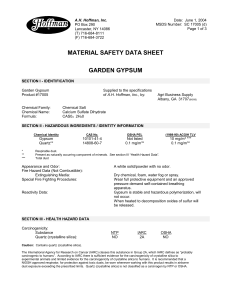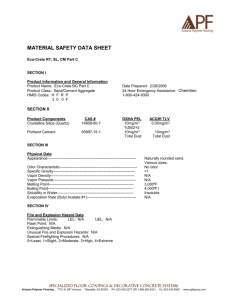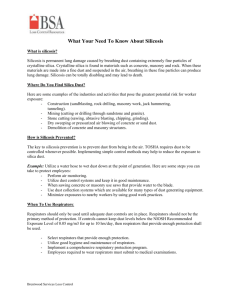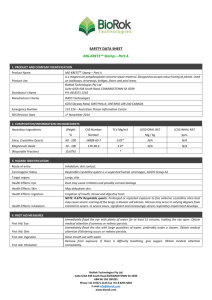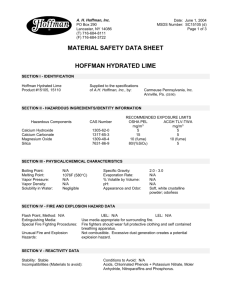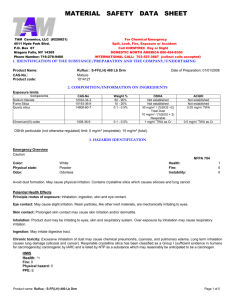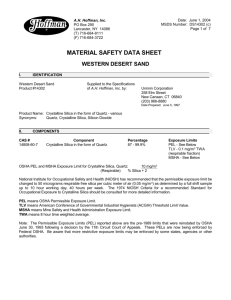material safety data sheet
advertisement
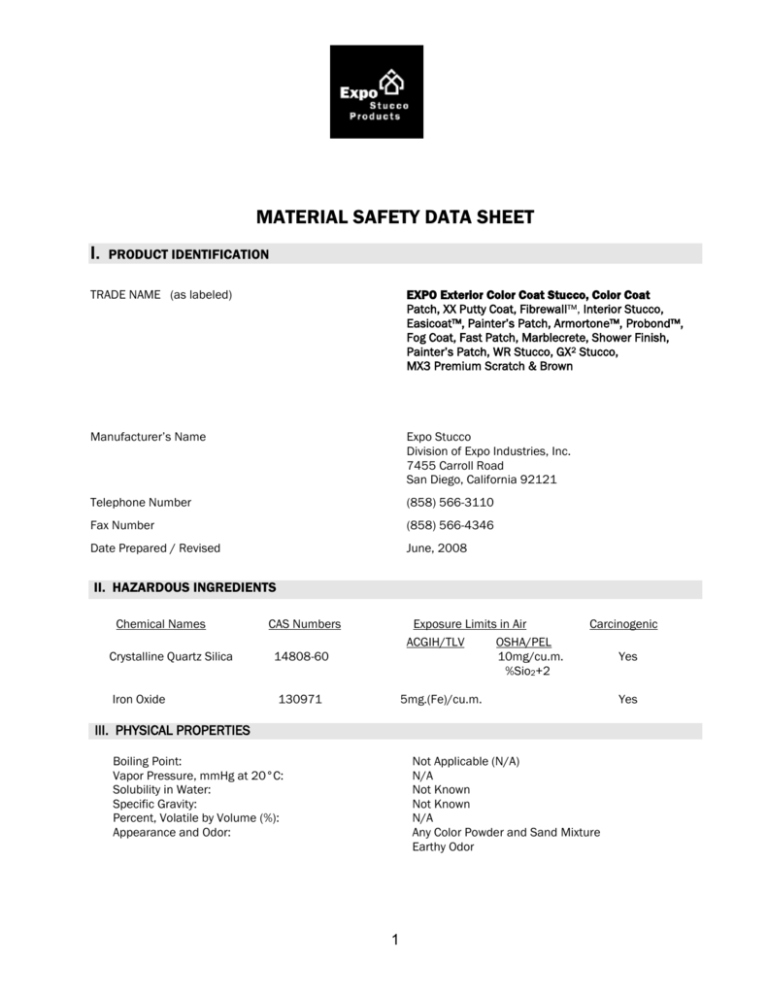
MATERIAL SAFETY DATA SHEET I. PRODUCT IDENTIFICATION TRADE NAME (as labeled) EXPO Exterior Color Coat Stucco, Color Coat Patch, XX Putty Coat, Fibrewall™, Interior Stucco, Easicoat™, Painter’s Patch, Armortone™, Probond™, Fog Coat, Fast Patch, Marblecrete, Shower Finish, Painter’s Patch, WR Stucco, GX2 Stucco, MX3 Premium Scratch & Brown Manufacturer’s Name Expo Stucco Division of Expo Industries, Inc. 7455 Carroll Road San Diego, California 92121 Telephone Number (858) 566-3110 Fax Number (858) 566-4346 Date Prepared / Revised June, 2008 II. HAZARDOUS INGREDIENTS Chemical Names Crystalline Quartz Silica Iron Oxide CAS Numbers Exposure Limits in Air ACGIH/TLV OSHA/PEL 10mg/cu.m. %Sio2+2 14808-60 130971 Carcinogenic 5mg.(Fe)/cu.m. III. PHYSICAL PROPERTIES Boiling Point: Vapor Pressure, mmHg at 20°C: Solubility in Water: Specific Gravity: Percent, Volatile by Volume (%): Appearance and Odor: Not Applicable (N/A) N/A Not Known Not Known N/A Any Color Powder and Sand Mixture Earthy Odor 1 Yes Yes IV. FIRE AND EXPLOSION Special Fire Fighting Procedures: Dolomitic hydrated lime dehydrates to magnesium oxide (350 0 C/ 6620 F) and calcium oxide (5800 C / 10790 F) and steam. If these upper temperatures prevail, wear self-contained breathing apparatus approved by NIOSH. Protect eyes from dust. The presence of Type S hydrated lime in a fire does not hinder the use of any standard extinguishing medium. Unusual Fire and Explosion Hazards: None. V. HEALTH HAZARD INFORMATION EFFECTS OF OVER-EXPOSURE: Acute: The contents include dolomitic hydrated lime which is an alkaline material. In the presence of moisture, contact with skin and eyes will cause irritation and possible severe corrosion damage. Short term exposure and irritation are generally without permanent effects, untreated contact and irritation can cause dermatitis and chemical burns. Inhalation of dust may cause lung damage. Chronic: Exposure to crystalline silica dust may cause scarring of the lungs with cough and shortness of breath, called "Silicosis". Prolong exposure to respirable crystalline quartz may cause delayed (chronic) lung injury. Acute or rapidly developing silicosis may occur in a short period of time in heavy exposure in certain occupations such as sandblasters. Silicosis is a form of disabling pulmonary fibrosis, which can be progressive and may lead to death. FIRST AID: Eye Contact: Wash eyes immediately with running water for 15 minutes, including under eyelids. Get prompt medical attention. Skin Contact: Wash exposure area with large amounts of water. Remove and wash contaminated clothing. Inhaled: Remove the individual from exposure to dust and get prompt medical attention. Swallowed: Dilute with large amounts of water or milk and get prompt medical attention. MEDICAL CONDITIONS AGGRAVATED BY EXPOSURE: Pulmonary function may be reduced by inhalation of respirable crystalline silica. Also lung scarring produced by such inhalation may lead to a progressive massive fibrosis of the lung which may aggravate other pulmonary conditions and diseases, and which increases susceptibility to pulmonary tuberculosis. Progressive massive fibrosis may be accompanied by right heart enlargement, heart failure and pulmonary failure. Smoking aggravates the effects of exposure. VI. REACTIVITY DATA Stability: Stable ___X____ Unstable _______ Conditions To Avoid: Handling procedures which may generate dust. Contact with nitroparaffins, maleic anhydride or phosphorous. Incompatibility (Materials To Avoid): Contact with powerful oxidizing agents such as fluorine, chlorine, tri-fluoride, manganese trioxide, oxygen di-flouride, may cause fires. Hazardous Decomposition Products (Including Combustion Products): Silica will dissolve in Hydrofluoric Acid and produce a corrosive gas-silicon tetrafluorid Hazardous Polymerization: May occur _______ Will not occur: _____X____ 2 VII. SPILL, LEAK AND DISPOSAL PROCEDURES Spill Response Procedures: Carefully pick up the solid with a minimum of dusting and collect in metal containers with covers for disposal. Do not dry sweep. Prepare Wastes For Disposal (Container Types, Neutralization, etc.): May be salvaged for use or removed to a landfill dump in accordance with regulations. VIII. SPECIAL PROTECTION INFORMATION Ventilation and Engineering Controls: Use dustless system for handling, storage and clean up so that airborne dust does not exceed the PEL. Provide general ventilation and local exhaust ventilation with appropriate dust collection to meet TLV and PEL requirements for reportable free silica dust. Respiratory Protection: NIOSH approved dust filter respirator in dusty conditions. Maintain, clean and fit respirators in accordance with OSHA regulations. Eye Protection (Type): Approved tight-fitting safety goggles. Gloves: Clean, dry, rubber gloves. Other Clothing and Equipment: Clean body-covering protective clothing, such as long-sleeved shirt with buttoned collar, long pants extending over the tops of work shoes. IX. SPECIAL PRECAUTIONS Work Practices / Hygenic Practice: Other Handling and Storage Requirements: Precautionary Labeling: Avoid creating and breathing dust. Store materials in sealed containers in a dry place. Product contains crystalline silica. WARNING Prolonged, repeated inhalation of product dust may cause delayed lung injury (silicosis). Our company relies on the information contained in MSDS's as permitted by the OSHA Hazard Communication Standard and does not perform independent hazard determinations 3
